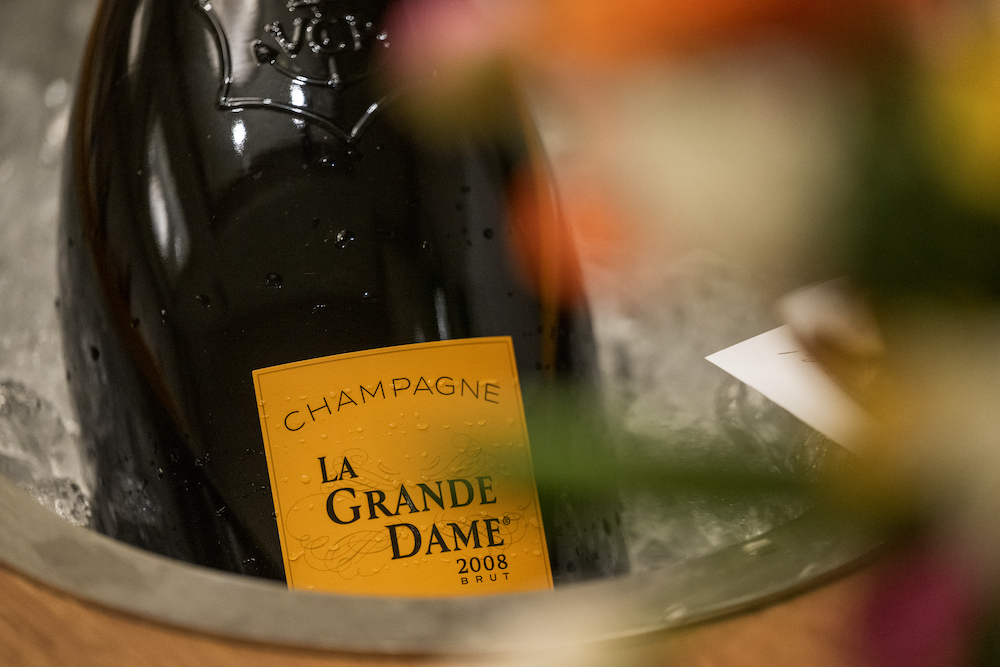
April 12, 2024 – If you drink Champagne, you’ve probably had Veuve Clicquot a time or two.
That distinctive yellow label is like the jaune jersey of the Tour de France: visible and way out in front, always at the top of wine lists and store shelves, and consequently—or because of—top of mind with Champagne drinkers, serious and casual.
This house of fine Champagne, part of the Louis Vuitton Moët Hennessey (LVMH) empire, produces about 19 million bottles per year, and is ranked the number two producer in terms of worldwide sales volume, with Moët-Chandon (another LVMH brand) number one at 28 million bottles annually. For reference, Taittinger makes 5 million bottles yearly, Louis Roederer bottles 9 million, Laurent-Perrier produces 6 million, Ruinart makes just 2.5 million and Krug (also LVMH), a measly 600,000.
If you’re curious, there are around 300 million bottles of Champagne produced in France yearly. The number one selling brand in France is the surprisingly nouveau co-op house Nicolas Feuillatte, established in 1972, and owning only 40 hectares of vineyards, meaning they buy most of their fruit. In contrast, Clicquot, established in 1772 in Reims by fabric merchant Phillipe Clicquot, today owns almost 400 hectares—95% of which are ranked Grand Cru or Premier Cru. Having those prized vineyards lends the wines inherent prestige.
Almost all of Veuve Clicquot’s production is their non-vintage Yellow Label. Precious little of their juice makes it into the La Grande Dame program, the tête de cuvée first created in 1962 in honor of the famous widow Barbe-Nicole Ponsardin Clicquot, who took over her husband’s wine business after his death at the age of 27. The French word for widow is veuve, hence Veuve Clicquot, and the legend around her is powerful and inspiring.
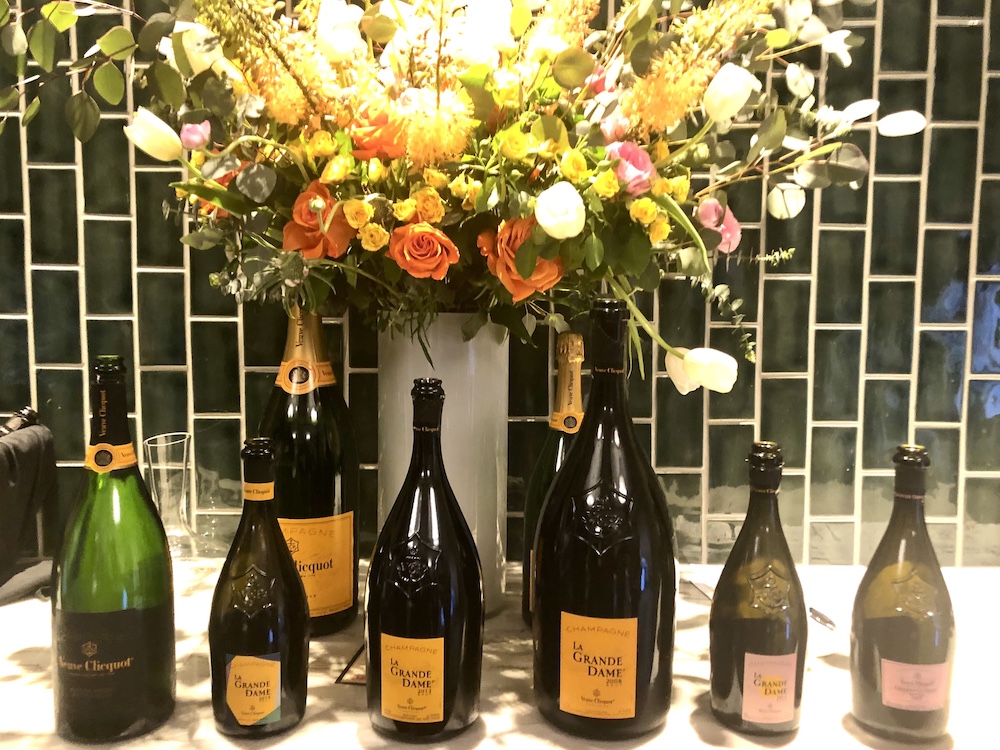
At the time of her husband’s demise, women could not own property in France unless they were widowed. Mdme Clicquot had been entrusted with a gem, and she took over the making of Champagne for the Clicquot brand, focusing on Pinot Noir as the core of her product. She also created the first vintage Champagne in 1810—previously all Champagnes had been blended vintages—and the first true rosé Champagne in 1818, which she made by adding still Pinot Noir from coveted Clos Colin in Bouzy, planted in 1741, and acquired by her in 1805. Previously, in 1764, Ruinart began the tradition of selling pink Champagne created by adding elderberry juice.
Barbe-Nicole is also credited with inventing the riddling table, allegedly drilling sideways holes into her kitchen table into which the necks of the bottles were inserted at an angle. By rotating the bottles, it encouraged all the sediment from the secondary fermentation to settle in the neck, so that it could be removed from the otherwise clear liquid before final bottling.
Champagne lovers of all bubble preferences were in for a treat at this year’s Pebble Beach Food and Wine, as they packed the room for the La Grande Dame En Garden seminar at the Inn at Spanish Bay.
It was a once in a lifetime chance to taste multiple vintages of La Grande Dame, guided by Veuve Clicquot winemaker Lison Blanchemanche, who is one of a team of 12 palates that goes through the massive cellar, where multiple vintages of base wine are stored, to come up with the Yellow Label cuvée each year.
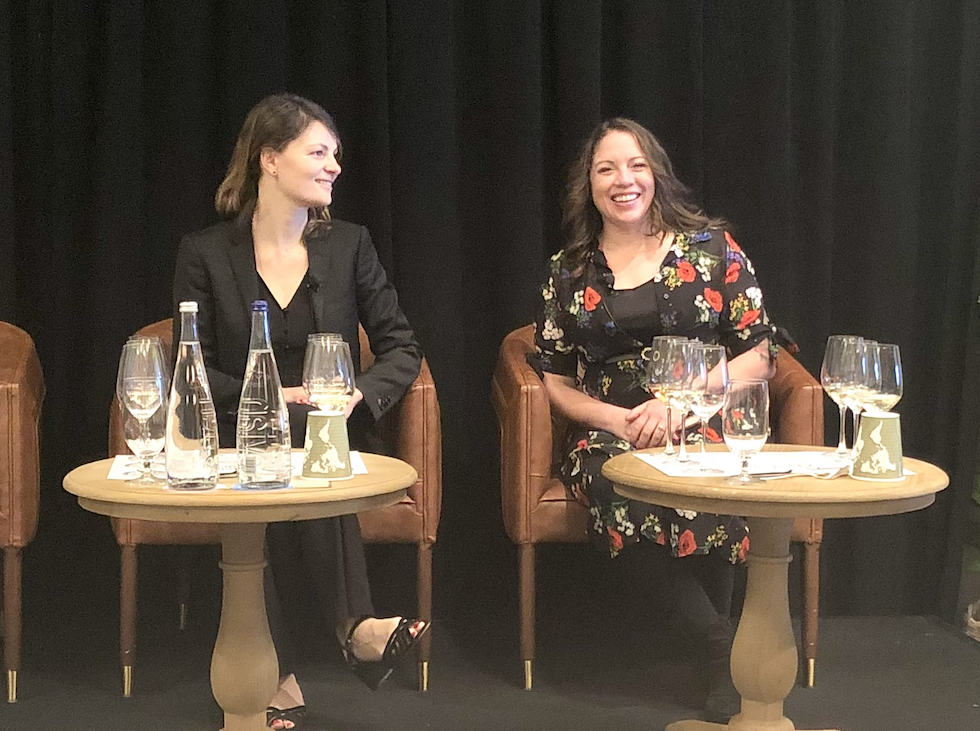
Broadly speaking, the Yellow Label blend is generally 50% Pinot Noir, 30% Chardonnay and 20% Pinot Meunier, taken from 50 to 60 different crus (vineyards), and, is composed of up to 45% reserve wines. Blanchemanche told us that Pinot Noir provides strength, Chardonnay provides freshness and Meunier, fruitiness. The aromatic richness and silky texture are driven by three years of lees aging for each of the wine’s components. Think of this wine as a peloton of Tour de France riders, all leaping into the same tank, preferably after they’ve showered, although bathing in Champagne would also be acceptable.
Blanchemanche was joined on the panel by Alicia Cuadra-Cutler, a Champagne specialist with Moët-Hennessey, who previously worked as a somm at Quail Lodge, along with Sarah Simms of Lady & Larder. Simms created a gorgeous plate of spring vegetables, freshly plucked from the garden, along with fresh cheese from friends in Cambria (Ragged Point triple crème, accompanied by honey made from their avocado trees), olive oil, hummus and outrageous butter by Stepladder Creamery, to accompany this symphony of liquid delight. Colorful pea shoots and edible flowers, inspired by the Veuve Clicquot gardens in Reims, added an exquisite touch. What a great way to start the day!
Emceed by June Rodil—CEO and Partner of Goodnight Hospitality in Houston, Texas, a longtime somm who had worked at PBFW in the past—this seminar was all about women, including an all female somm team who poured the set of six bubbles, from 750s, magnums and Jeroboams. The bigger the format, the fresher the wine, a lesson in why large formats are what you want if you’re saving a special vintage for multiple decades.
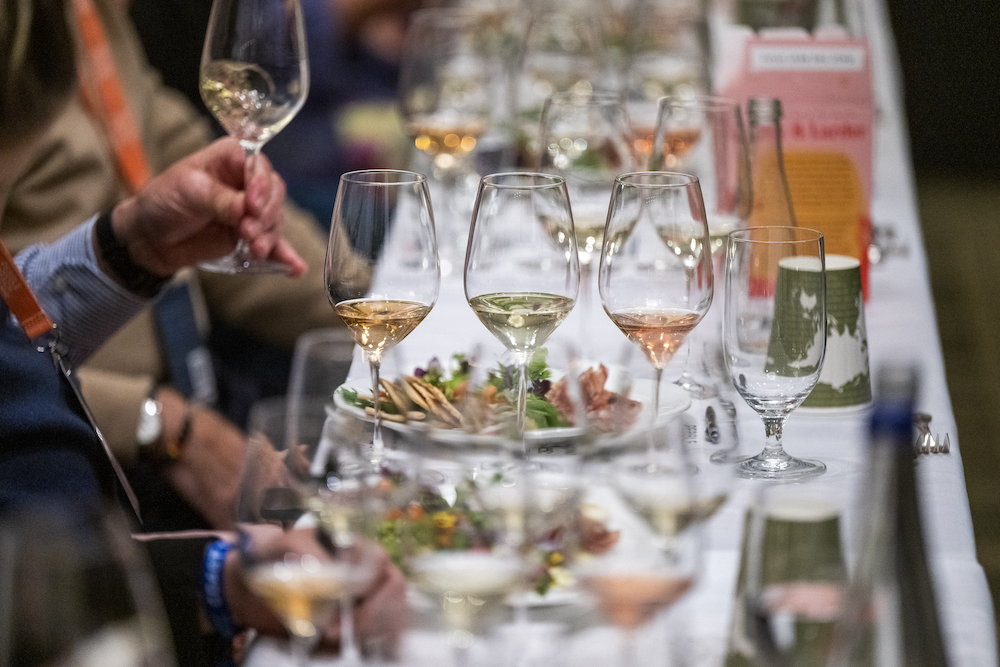
Blanchemanche, who has been with the company for 12 years and is studying for her winemaking diploma, admits that she is thoroughly imbued with the “spirit of the company,” and says she has “yellow blood” in her veins. Asked how the team of 12 can come to agreement on all these pieces and parts—they taste 1,200 samples between November and February, preparing Yellow Label and La Grande Dame—she says that Cellar Master Didier Mariotti, one of only 11 to have served the house over its entire history, distills it down to a matter of vertical and horizontal geometry: essentially, two axes, with vertical flavors representing precision and horizontal representing breadth. The ideal wine is at that harmonic intersection of the two.
She guided us through six vintages of Veuve Clicquot’s special cuvées, telling us that their goal is to always produce wines of the highest quality and consistency, year over year. The Extra Old and La Grande Dame cuvées represent less than 1% of all of Veuve Clicquot’s production, so the experience was extra special.
One thing you’ll notice straight away is the dramatic jump in the percentage of Pinot Noir in the La Grande Dame cuvée between 2006 and 2008. Since then they’ve never wavered from that commitment to Pinot Noir, creating a dramatic difference between the Veuve style and the Ruinart style, which is heavily Chardonnay based.
- Veuve Clicquot Extra Brut Extra Old 4 (Magnum) – A unique blend of six of Veuve Clicquot’s most prestigious reserve wines: 1996, 2008, 2010, 2012, 2013 and 2014. This is truly an extraordinary feat of blending, with aromas of limestone, citrus, pear and honeysuckle, and the palate is marked by soft, fine bubbles. This is refined stuff, perfect for breakfast with raw vegetables and for lunch or with starter courses of tartare and seafood.
- 2015 La Grande Dame (750ml) – 90% Pinot Noir, 10% Chardonnay – Wonderfully aromatic, intense and tropical, from a very sunny and agreeable vintage, this wine reflects perfectly what Blanchemanche described as the fusion of energy from the northern vineyards and the ripeness and maturity of those to the south. It opens with jasmine, acacia, and narcissus, and plenty of energy and vibrance on the palate. “This is a wine of great vitality,” Blanchemanche declared.
- 2012 La Grande Dame (Magnum) – 90% Pinot Noir, 10% Chardonnay, 100% Grand Cru – Everything about this wine is grand, except the harvest from which it originated. It was a wet spring with stingy set and a small harvest, but what resulted is concentrated, from aroma to palate, opening with preserved lemon, dried fig and carnations, with dried apple, white fig and bitter orange marmalade on the palate. This has the stuffing to be spectacular as it matures.
- 2008 La Grande Dame Rosé (Jeroboam) – 92% Pinot Noir, 8% Chardonnay, 14% Clos Colin Pinot Noir – One of Blanchemanche’s favorites, this wine gets its rosy hue and body from the 14 percent Pinot Noir grown in the revered Clos Colin parcel in Bouzy. What has been called “the vintage of the century,” 2008 brought a cold and dry summer, with warm sun just before harvest, imparting good ripeness along with freshness and tension that’s impossible to resist. The delicate but persistent smokiness that accompanies the dried flower aromas evokes goat cheese, and the huge mousse, along with sleek raspberry and blood orange marmalade, lend the rosy copper-hued wine with flecks of gold an opulence that makes it a standout. Simms declared it “a chef’s dream,” while Cutler agreed that Champagne rosé is on another level, stating that these rosés are the powerhouses of the Veuve Clicquot portfolio. Simms waxed poetic about the “rosé lifestyle,” saying that she could drink it all day, and that her last two cars have had a license plate reading “rosé.” From her pink apron, it was clear she is all in on the concept.
- 2008 La Grande Dame (Jeroboam) – 92% Pinot Noir, 8% Chardonnay – Reflecting the pure Champagne base to which the still Pinot Noir is added to make the prior rosé version, the 2008 Grande Dame is a treasure of spice, leather, sandalwood and cherry, with a powerful mousse that gives it the body and strength to stand up to cured meats, like the salami with fennel, mustard seed and pink peppercorns that Simms included on the plate. This wine had a ferocity to it that made a statement.
- 2006 La Grande Dame Rosé (Magnum) – 53% Pinot Noir, 47% Chardonnay, 15% Clos Colin Pinot Noir – What a treat to taste the “before” approach to La Grande Dame, which contained four times more Chardonnay than anything from 2008 going forward. The Chardonnay plays to the expanded midpalate of this wine, its delicate yet intensely minerally mousse lavish with ginger and salinity, yet lacquered by the fresh red raspberry and vivid red licorice from the Clos Colin Pinot Noir. This wine is stunning, but much more subtle than the 2008.
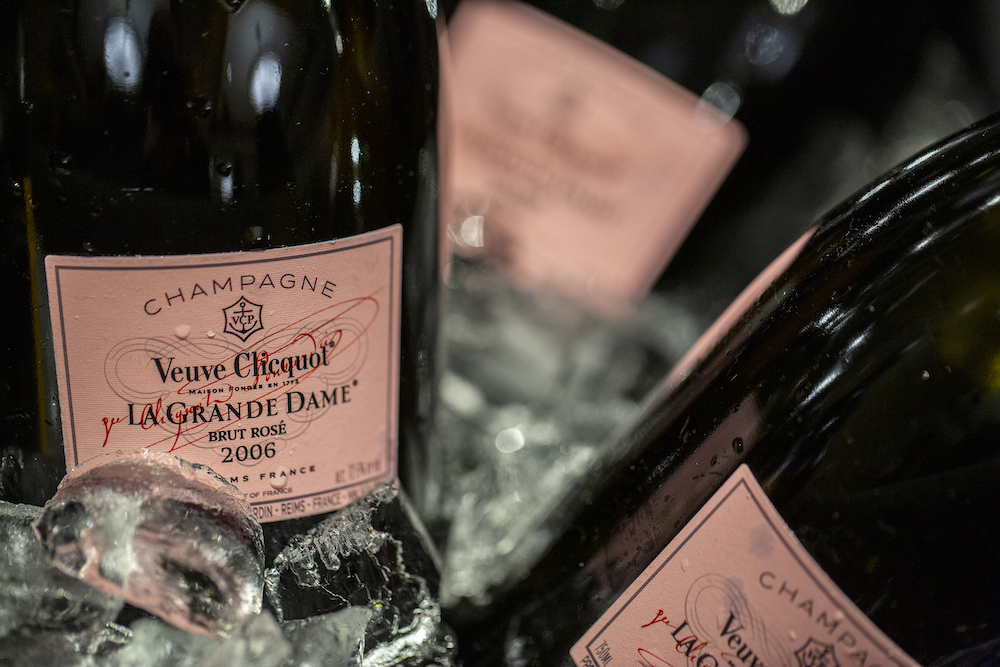
Both of the rosé Champagnes were so much earthier, weightier and more substantial than their counterparts that they perfectly complemented the earthiness of the radishes and the z’aatar-topped hummus on the Lady & Larder plate, and made me rethink what to pair with still rosés as well as bubbly ones. These pink rascals love to play with herbaceousness. Simms reminded us that the French love to eat breakfast radishes with butter, and, naturally, Champagne.
As I ate one of the radishes, leaves and all, I was reminded of Vivian Leigh in “Gone With The Wind,” where she pulls a sickly radish out of the ground, and shakes her fist, proclaiming, “As God is my witness, I will never be hungry again!” How differently the story might have ended had she accompanied that radish with a bottle of Veuve!
Here’s a toast to bold, strong women throughout time who have changed the course of history and to those who do so every day.
Note: Veuve Clicquot is the subject of the fascinating historical fiction work, “Champagne Widows,” by Rebecca Rosenberg, who also wrote a book called “Madame Pommery,” about a much younger contemporary of Mdme Clicquot, who took over the House of Pommery (founded in 1857), and was the first to produce Brut Nature, an unsweetened Champagne. Previously all Champagnes had a very high dosage of sugar.
About the author
Laura Ness is a longtime wine journalist, columnist and judge who contributes regularly to Edible Monterey Bay, Spirited, WineOh.Tv, Los Gatos Magazine and Wine Industry Network, and a variety of consumer publications. Her passion is telling stories about the intriguing characters who inhabit the fascinating world of wine and food.
-
Laura Nesshttps://www.ediblemontereybay.com/author/lness/
-
Laura Nesshttps://www.ediblemontereybay.com/author/lness/
-
Laura Nesshttps://www.ediblemontereybay.com/author/lness/
-
Laura Nesshttps://www.ediblemontereybay.com/author/lness/


